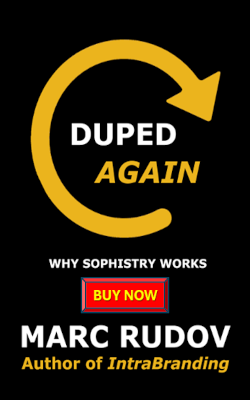
| AGILITY | The ability to perceive situations and preempt or respond to them quickly. Read Intrabranding: The Keystone of Corporate Agility |
| ARTIFICIAL EMOTIONAL INTELLIGENCE | AKA AEI. An emotional immaturity and psychological detachment caused by excessive use of social media. It causes the afflicted to believe, falsely, that they behave maturely and can both detect and inspire mature behavior in others. AEI presents a serious branding challenge to CEOs, as branding must be bold and provocative to succeed. For example, infantilized Millennials are offended by every word and idea that promote individual freedom. |
| ARTIFICIAL INTELLIGENCE | Making decisions without critical thinking. Doing so will kill your brand and your company. Read “Justify Your Artificial Intelligence.” |
| BRAND | Customer-validated value proposition, expressed in customer language — never in product, industry, or technology jargon. Sets company’s purpose and direction. Determines people hired, products built, and processes implemented. NOT a product or product name, company or company name, technology, or logo. |
| BRANDING | The act of creating and articulating the brand, the value proposition, which makes a visceral connection with customers, investors, and reporters. CEO’s #1 priority. Two components: message and megaphone — and message trumps megaphone. Branding always begins on first day of company’s existence; precedes products, customers, and revenues; and is never subordinated to any other activity. VIDEO: “Five Stages of Branding” |
| CEO | Chief executive officer. Brander-in-chief. Ultimately responsible for creating, fine-tuning, and enforcing brand. |
| CRYPTOBRANDING | Intentionally (jargon) or inadvertently (incompetence) making value proposition so arcane that nobody can grasp it, rendering company a look-alike, sound-alike generic commodity. |
| DEBRANDING | Antithesis of branding. Blending. Fitting in. Copying competitors. Using jargon. |
| DESIGN THINKING | The latest business buzzword. Synonym for branding. Long-term set of solutions, devised BEFORE designing products. Tied to customers’ needs — not engineers’ whims and technological fads. |
| ELEVATOR PITCH | The reason-for-being spiel that some venture capitalists believe a CEO can deliver to an awkward prospect while riding between floors in an elevator. Flawed idea. VIDEO: “Ditch the Elevator Pitch” |
| ENTROPRISE | Enterprise with a weak brand. Directionless, chaotic, in a state of entropy. Makes bad hiring decisions, resists firing incompetent employees, implements poor policies, is slothful, develops off-target or inferior products, and is impossible to fathom. READ: Brand Is Destiny |
| FOO | Fear of offending, killer of brands. Politically correct CEOs have this fear — because every word in the English language is now an offensive trigger. Read about it in Chapter 6 (Millennial Mania) of Brand Is Destiny |
| GENERIC | Common. Opposite of unique. Without a brand. Jargon renders any company or product generic. |
| GutShare™ | As all decisions are gut-based, the amount of space a supplier occupies in customers’ guts. Replaces mindshare, which is totally meaningless, because people don’t make cerebral decisions. |
| INDUSTRY | Group of products & services, and their suppliers, typically segmented by SIC, NAICS, and geography. Not a market. |
| INNOVATION | The continuous process of enhancing customers’ lives, according to them, with products and services. Requires effective intrabranding to be successful. A product or service that doesn’t achieve this, therefore, is not an innovation. Read Intrabranding: The Keystone of Corporate Agility. |
| INTRABRANDING | Continuously selling and enforcing your corporate brand inside your enterprise, so that employees and management accept and adopt that brand. Read Intrabranding: The Keystone of Corporate Agility. |
| JARGON | Internal or industry vernacular. The bane of branding. Killer of brands. Ambrosia of the untalented. |
| LABEL | Sticker, marker, or tab, affixed to a product, that typically conveys the product’s name, features, logo, and maker. Often mistakenly confused with a brand. |
| LIKAHOLIC | Person hopelessly addicted to “liking” posts on social media, without knowing or caring what he’s liking. Social media are full of likaholics, which is why you shouldn’t base your company’s success on social media. |
| MARKET | Group of people, typically segmented by demographics, psychographics, or geography. NOT a product, company, technology, or industry. VIDEO: “What Is a Market?” |
| MARKETING | Subset of branding. Determining which customers (market) to serve, their problem to solve, the solution they’ll buy, the price they’ll pay for said solution, and the best sales and promotion channels to reach them. |
| MARKETPLACE | Nexus where market and industry meet, where products are conveyed, priced, and promoted. |
| MARKET RESEARCH | Studying the lives, habits, wants, needs, concerns, fears, likes, dislikes, and idiosyncrasies of people. Independent of product research. |
| MEGAPHONE | The conduit through which one transmits the brand’s message. VIDEO: “Message Trumps Megaphone” |
| MESSAGE | Synonym for brand. VIDEO: “Message Trumps Megaphone” | VIDEO: “Verify Your Message” |
| PERSONAL BRANDING | Euphemism for self-promotion. It is all the rage today. Essentially, it is nothing more than cringeworthy, self-aggrandizing narcissism. To learn more, CLICK HERE |
| POSITIONING | Synonym for branding, only if the positioning registers in customers’ guts (see GutShare™ above). |
| PRODUCTING | Antithesis of marketing and branding. Primary activity of those who falsely believe a product is a market, especially in high-tech circles. Specifically, the practice of focusing on and building a company around products — instead of a customer-validated brand. |
| PRODUCT RESEARCH | Studying how and why customers and potential customers use current products and may use future products. |
| PUBLIC RELATIONS | AKA PR. The art of getting free publicity by spinning tactical objectives — spreading the word about new products or controlling the damage from mishaps. PR is not branding; branding is not PR. |
| SOCIAL MEDIA | Collection of sites — Facebook, Twitter, Instagram, etc. — which people use to hype, snipe, and gripe. Many falsely believe social media are useful for branding and selling: Harvard Business Review debunked that myth. Sixty percent of Twitter users don’t even read the tweets they share. |
| SOCIAL MEDIAPATHY | Result of spending time on social media, akin to submerging oneself in a sensory-deprivation tank, leaving one isolated and desensitized — unable to perceive, feel, and communicate with real human beings. (READ: Brand Is Destiny) |
| TECHNOLOGICA EROTICA | A psychological condition whereby technology causes such a high level of sexual arousal in people that they cannot fathom its sole purpose as a building block, an ephemeral means to an end. Many sufferers believe technology is the solution to every problem and should supplant people in every situation, no matter the level of stupidity and danger (e.g., driverless cars, smart homes). |
| TECHNOLOGICAL CORRECTNESS | Akin to political correctness, the pressure to conform to and accept technologies and the concomitant jargon (cloud, SaaS, IoT, etc.), regardless of their defects. Learn more in Brand Is Destiny. |
| TECHNOLOGISM | The blindly followed religion of technology, omnipresent in Silicon Valley and its derivatives. The central tenet is that technology MUST solve every problem in life. Learn more in Brand Is Destiny. |
| UBIQUE | Common, generic. Opposite of unique. Root of ubiquitous. |
| UNIQUE | Literally one of a kind. Sui generis. Opposite of generic. Binary property: no degrees. A brand that isn’t unique is not a brand. READ Be Unique or Be Ignored. |
| VALUE PROPOSITION | The brand. Expressed in customer language, the value a company provides to its customers. Without delivering on that proposition, it is null and void. |
| WORD OF MOUTH | The verbal spread, from person to person, of a strong brand’s essence. Buzz. A brand resonates when people react to it, remember it, and repeat it. |

